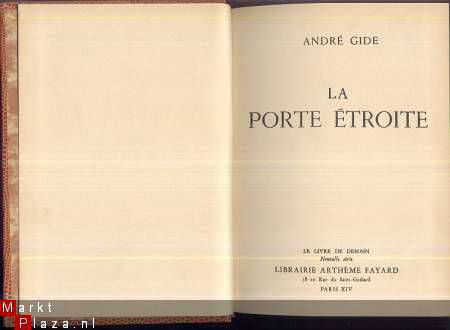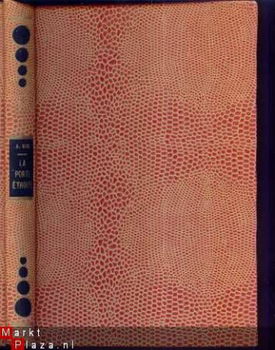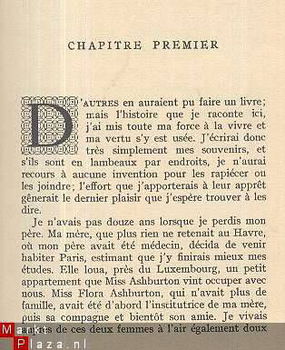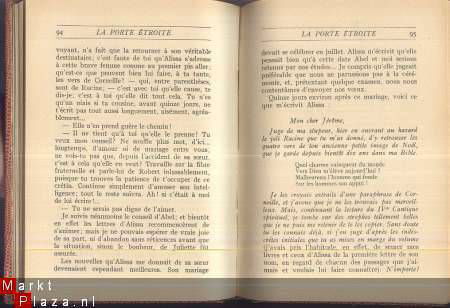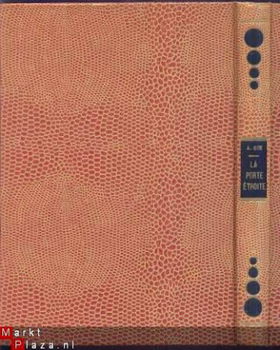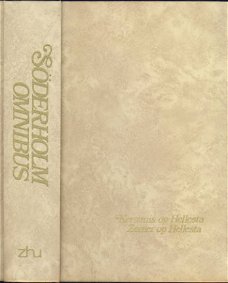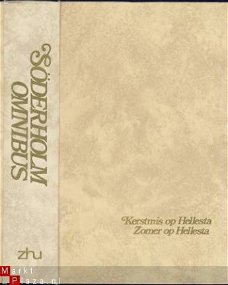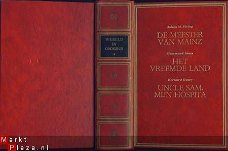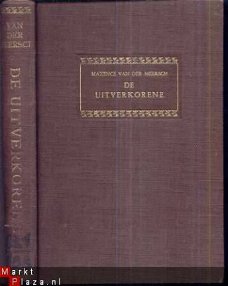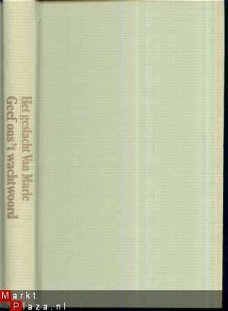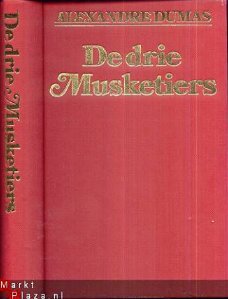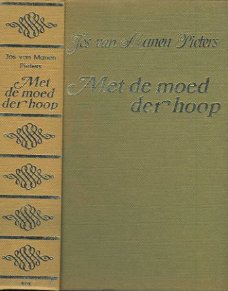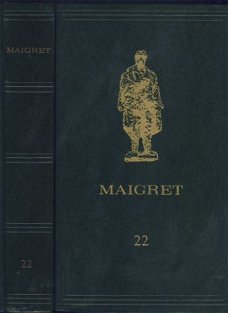
ANDRE GIDE**LA PORTE ETROITE**ARTHEME FAYARD*LIVRE DE DEMAIN
Kenmerken
- Conditie
- Gebruikt
- Levering
- Niet van toepassing
Omschrijving
ANDRE GIDE
(1869-1951)
***LA PORTE ETROITE***
LIBRAIRIE ARTHEME FAYARD.
LIVRE DE DEMAIN NOUVELLE SERIE
++HARDCOVER++
18-20 RUE DE SAINT GODARD, PARIS, XIV.
ARTICLE INVENTAIRE CODE 5.222
FORMAT 185 X 132 X 22 + 189 PGS + 242 GRS
EXPED. EN BELGIQUE 2,35 EURO
French writer, humanist, and moralist who received the Nobel Prize for Literature in 1947. As a novelist, and still more as an intellectual figure, Gide has appealed to different audiences: a traditional psychological novelist to some, an innovative modernist to others; he was a major literary critic, social crusader, and spokesman for homosexual rights. Gide's search for self - the underlying theme of his several works - remained essentially religious. Throughout his career Gide used his writings to examine moral questions. He is as well known for his influence as a moralist and as a thinker as for his contributions to literature.
"It is not so much about events that I'm curious, as about myself. There's many a man thinks he's capable of anything, who draws back when it comes to the point... What a gulf between the imagination and the deed! And no more right to take back one's move than at chess. Pooh! If one could foresee all the risks, there'd be no interests in the game!... Between the imagination and a deed and... Hullo! the bank's come to an end. Here we are on a bridge, I think, a river..." (from The Vatican Cellars, 1952)
André Gide was born in Paris. His father, Paul Gide, a professor of law at the University of Paris, was descended from Cévennes Huguenots. He died in 1880. In SI LE GRAIN NE MEURT... (1924-26, If It Die: An Autobiography), Gide recalled that his father "spent most of the day shut up in a vast and rather dark study, into which I was only allowed when he expressly invited me." In his study he read his son works by Molière, passages from the Odyssey, and after discussing with his wife, also the first part of the Book of Job. "But the reading certainly made the deepest impression on me, not only because of the solemnity of the story, but because of the gravity of my father's voice and my mother's expression, as she sat with her eyes closed, in order alternately to signify or to shield her pious absorption, and opened them only to cast a questioning glance on me, full of love and hope." (from If It Die)
Gide was raised by three women - his Aunt Claire, the English spinster Anna Shackleton, and his Calvinist mother, Juliette Rondeaux, who devoted her life to him. In his childhood Gide was educated mostly at home - he was lonely and ill for long periods. At the age of 13, Gide fell in love with his cousin Madeleine Rondeaux; they married 12 years later, but in 1923, after twenty-seven years of unconsummated marriage, Gide had a daughter, Catherine, by another woman. Catherine's mother, Maria Van Rysselberghe, wrote about Gide's domestic life in Cahiers de la Petite Dame 1918-1945 (1973-77). Madeleine died in 1938, his unconsummated "marriage of Heaven and Hell" Gide dealt in ET NUNC MANET IN TE (1951).
Gide attended several schools. At the École Alsacienne Gide developed an interest in literature. He made friends with other aspiring writers and artists and attended the literary salons of José Maria de Heredia and Stéphane Mallarmé. In 1891 Gide made his debut as a novelist with LES CAHIERS D'ANDRÉ WALTER. He had started to write it at the age of 18. The book, published anonymously, told the story of an unhappy young man and his pure love for his cousin Emmanuèle. Next year appeared his first collection of poems, POÉSIES, but by 1900 he had practically abandoned poetry.
In 1893 and 1894 Gide traveled to North Africa, learning different moral and sexual conventions. At Biskra Gide fell ill and narrowly escaped death. These experiences gave basis for his psychological novels The Immoralist (1902), about the destructive force of hedonism and hunger for new experiences, and Strait is the Gate (1909), the counterpoint of the former work, or the "twin", as Gide called it. "The capacity to get free is nothing," says Mchael, the narrator of the Immoralist, "the capacity to be free, that is the task." In PALUDES (1895) Gide examined ironically his former life; Africa had made him accept his sexual inclinations. He became close friends with Oscar Wilde whom he met in Algiers, and whose caricature Gide drew in his memoir. The Immoralist played with the dialogue between the inner narrator and the outer narrator.
"Families, I hate you! Shut-in homes, closed doors, jealous possessions of happiness." (from Fruits of the Earth)
Gide's hymn in prose and poetry to the beauty of all, Fruits of the Earth, appeared in 1897. It became in the 1920s his most popular work, influencing a generation of young writers, including the existentialists Albert Camus and Jean-Paul Sartre, to cast off all that is artificial or merely conventional. In 1909 Gide helped found the influential literary magazine Nouvelle Revue française (The New French Review). For it he wrote a large number of essays and reviews. Gide rejected nationalism in French literature. He stated that "great minds never fear influences; on the contrary, they seek them with a sort of eagerness like the eagerness of being." Gide's defense of homosexuality in CORYDON, published first privately in 1911, was violently attacked. In the 1930s he announced his conversion to Communism, which shocked his readers, but he also was rejected by his new admirers after his disillusioning trip to the Soviet Union. In RETOUR DE L'URSS (1936) Gide made a decisive break with the Soviets.
In 1916 Gide started to keep a second journal, in which he recorded his search for God. His religious crisis of 1915-16 Gide analyzed in NUMQUID ET TU...? (1922). On 4 August 1922 he wrote in the journal, "I present my own ethics under the cover of Dostoevsky." Gide's interest in the Russian writer went back to his youth. In 1923 he published a book on Dostoevsky, which consisted mainly on lectures and earlier writings. Gide noted that Dostoevsky's main ideas were expressed through his characters: "He lost himself in each of the characters of his books and for this reason it is in them that he can be found again." Gide also recorded his everyday observations in his journal, examining often vices mirroring the problems of society. "10 May 1927: Many opium smokers and cocaine addicts in Zurich. Some of them, Rychner tells me, began to inject themselves during their last year at the Gymnasium; that is, when aged sixteen or seventeen. He knows one whom the professors caught using a syringe in a final examination. Cornered, he confessed that he had got his habit in class. 'Do you think anyone could endure the dullness of X's teaching without shooting up?' he asked."
After the mid-1920s Gide became a champion of society's victims, who demanded more humane conditions for criminals. He had observed social injustices more closely than many other writers from the 1890s - first as mayor of a commune in Normandy (1896), and later as a juror in Rouen (1912), and then as a special envoy of the Colonial Ministry (1925-26). In July 1925 Gide set out for a journey to the Congo with his friend Marc Allegret, returning in 1927. During this time Gide published If It Die..., which has been compared to Jacques Rousseau's Confessions.
In the novel The Counterfreiters (1926) Gide exposed the hypocrisy and self-deception with which people try to avoid sincerity. The protagonist, Edouard, keeps a journal of events in order to write a novel about the nature of reality. Another internal author - the 'pseudo-author', an intervening first person voice - comments the action. Edouard falls in love with his nephew Oliver Molinier. Through their story Gide illustrates what he considered a constructive homosexual relationship. Numerous themes are woven into the complex structure, not only the novelist writing a novel about a novelist who is writing a novel about forging. The intrigues of a gang of counterfeiters symbolize the counterfeit personalities with which people disguise themselves. The novels ends with the suicide of one of the characters.
In The Pastoral Symphony (1919), written in the form of the diary, Gide explored the hypocrisy which masquerades as Christian pity and duty. In the story a Swiss Protestant pastor adopts and educates the blind orphan Gertrude. The pastor is afraid that Gertrude loves him less than his son Jacques, and seduces the girl on the eve of an operation, which may restore her sight. After the successful operation, Gertrude understands the truth about the people around her and she commits suicide. The pastor doesn't realize his own blindness before he starts to re-examine his own thinking and behavior. The film version of the book, directed by Jean Delannoy, gained critical and popular success in 1946, but the author himself was not happy with the result. Delannoy gave Gerture her sight some two-thirds of the way through the film, not at the end. The novella, Gide claimed, "makes sense only in terms of its artistic construction. It is, in sum, a tragedy in five acts which takes on its final value only through the long night of the first four acts. The young blind girl recovers her sight only in the last pages - to her detriment as it turns out. Everything resides in this sudden rupture. They explained to me that the necessities of the screen warranted a new conception of the tale, that it had to be translated into another language." The novella Isabelle exposed illusions of a young student, who falls in love with a woman pictured in a mysterious miniature. It was published in the UK in the same volume as La Symphonie Pastorale.
From 1942 until the end of WW II, Gide lived in North Africa. In the 1940s he began receive honors, which culminated in the Nobel Prize. Gide's correspondence with his friends Francis Jammes (pub. 1948) and Paul Claudel (pub. 1949) reveals their unsuccessful attempt to convert the author to Catholicism. Among Gide's later works is THÉSÉE (1946), which contributed to the renewed use of Greek myth in the 20th century literature. Gide died on February 19, 1951. The Catholic Church placed his works on the Index in 1952. Gide's wide correspondence with Proust, Paul Claudel, Rainer Maria Rilke, Paul Valéry, Martin du Gard, and others started to appear regularly in 1948.
For further reading: Le Dialogue avec André Gide by C. Du Bos (1929); André Gide by R. Fernandez (1931); André Gide by J. Hytier (1938); Portrait of André Gide by Justin O'Brien (1953); Theory and Practice of the Novel: A Study of André Gide by W. Wolfgang Holdheim (1968); André Gide by G.W. Ireland (1970); Gide: A Study by Christopher D. Bettinson (1972); Portraits of Artist by Arthur E. Babock (1982); Fiction et vie sociale dans l'oeuvre d'André Gide by Alain Goulet (1985); André Gide and the Codes of Homotextuality by Emily S. Apter (1987); Réflections sur 'Les Faux-Monnayeurs' by Pierre Masson (1990); André Gide by David H. Walker (1990); Andre Gide: A Life in the Present by Alan Sheridan (1999) - Noter sur André Gide by Roger Martin du Gard - See also: Olavi Paavolainen, Saint-John Perse, Colette, Francois La Rochefoucauld, Rainer Maria Rilke
Selected works:
LES CAHIERS D'ANDRÉ WALTER, 1891 - The Notebooks of André Walter
LE TRAITÉ DU NARCISSE, 1891 - Narcissus
LES POÉSIES D'ANDRÉ WALTER, 1892
LE VOYAGE D'URIEN, 1983 - Urien's Voyage
LA TENTATIVE AMOUREUSE, 1893 - The Lover's Attempt, trans. in The Return of the Prodigal
LE VOYAGE D'URIEN, 1893 - Urien's Travels
PALUDES, 1895 - Marshlands
LES NOURRITURES TERRESTRES, 1897 - Fruits of the Earth
LE PROMÉTHÉE MAL ENCHAÎNÉ, 1899 - Prometheus Illbound / Prometheus Misbound
EL HADJ, 1899 - trans.
PHILOCTÈTE, 1899 - Philoctetes
LE ROI CANDAULE, 1901 - King Candaules
L'IMMORALISTE, 1902 - The Immoralist
SAÜL, 1903
PRÉTEXTES, 1903
AMYNTAS, 1906 - trans.
LE RETOUR DE L'ENFANT PRODIGUE, 1907 - The Retour of the Prodical
LA PORTE ÉTROITE, 1909 - Strait is the Gate - Ahdas portti
OSCAR WILDE, 1910 - trans.
ISABELLE, 1911 - trans.
NOUVEAUX PRÉTEXTES, 1911
BETHSABÉ, 1912 - Bathsheba
SOUVENIRS DE LA COUR D'ASSISES, 1914 - Recollections of the Azzize Court
LES CAVES DU VATICAN, 1914 - The Vatican Cellars / Lafcadio's Adventures
LA SYMPHONIE PASTORALE, 1919 - The Pastoral Symphony - Pastoraalisinfonia - film 1946, dir. by Jean Delannoy, screenplay by Jean Aurenche and Pierre Bost, starring Michele Morgan, Pierre Blanchar, Line Noro, Jean Dessailly. - "And so we have in this film a wonderful example of a type of film worth looking at, but a type which, though especially dependent on adaptation, was not supple enough to do justice to the literature it celebrated." (Dudley Andrew in Modern European Filmmakers and the Art of Adaptation, ed. by Andrew S. Horton and Joan Magretta, 1981)
MORCEAUX CHOISIS, 1921
NUMQUID ET TU...?, 1922
DOSTOÏEVSKY, 1923 - Dostoevsky
CORYDON, 1924
INCIDENCES, 1924
SI LE GRAIN NE MEURT..., 1924-26 - If It Die... - Ellei vehnänjyvä kuole
LES FAUX-MONNAYEURS, 1926 - The Counterfeiters - Vääränrahantekijät
LE JOURNAL DES FAUX-MONNAYEURS, 1926 - The Journal of the Counterfeiters
VOYAGE AU CONGO, 1927 - To the Congo, in Travels in the Congo
LE RETOUR DU TCHAD, 1928 - Back from the Chad, in Travels in the Congo
ESSAI SUR MONTAIGNE, 1929 - Montaigne
L'ECOLE DES FEMMES, 1929 - The School for Wives - Naisten koulu
ROBERT, 1929 - trans.
LA SÉQUESTRÉE DE POITIERS, 1930
NE JUGEZ PAS, 1930 - Andre Gide, Judge Not (trans. by Benjamin Ivry)
ŒDIPE, 1931 (play) - Oedipus
DIVERS, 1931
PERSÉPHONE, 1934 - Persephone
LES NOUVELLES NOURRITURES, 1935 - The New Fruits, in Fruits of the Earth
GENEVIÈVE, 1936 - Genevieve
RETOUR DE L'URSS, 1936 - Return from the U.S.S.R.
RETOUCHES À MON "RETOUR DE L'USSR", 1937 - After thoughts on the U.S.S.R.
JOURNAL 1889-1939, 1939
LE TREIZIÈME ARBRE, 1942
ATTENDU QUE, 1943
INTERVIEWS IMAGINAIRES, 1943
DEUX INTERVIEWS IMAGINAIRES, SUIVIS DE FEUILLETS, 1946
JOURNAL 1939-42, 1946
THÉSÉE, 1946 - Two Legends: Oidipus and Theseus
NOTES SUR CHOPIN, 1948 - Notes on Chopin
FEUILLETS D'AUTOMNE, 1949 - Autumn Leaves
ROBERT; OU, L'INTERÊT GÉNÉRAL, 1949
LITTÉRATURE ENGAGÉE, 1950
JOURNAL 1939-49, 1950
ET NUNC MANET IN TE, 1951 - The Secret Drama of My Life / Madeleine
AINSI SOIT-IL, 1952 - So Be It
ŒUVRES COMPLÈTES, 1932-1954
